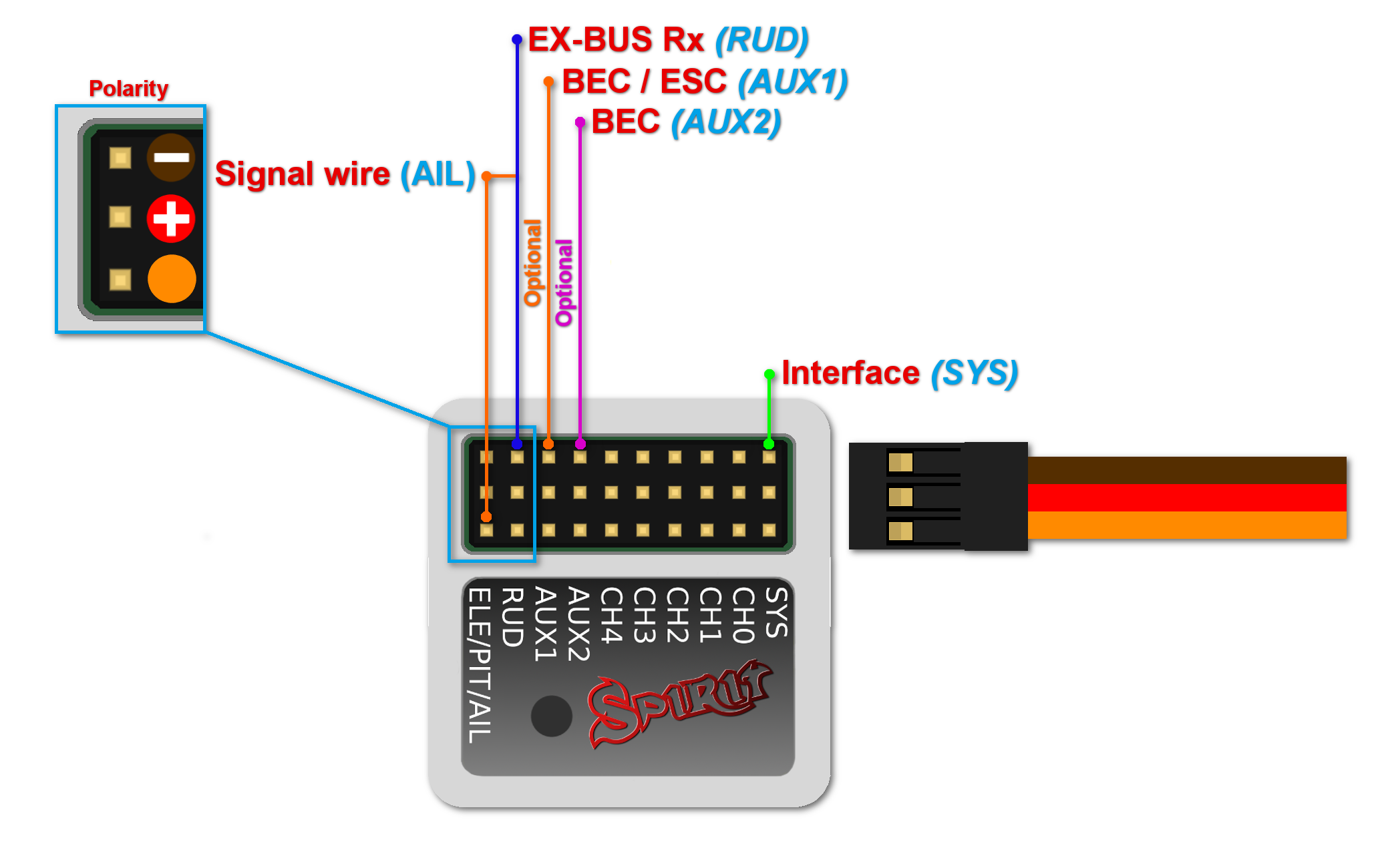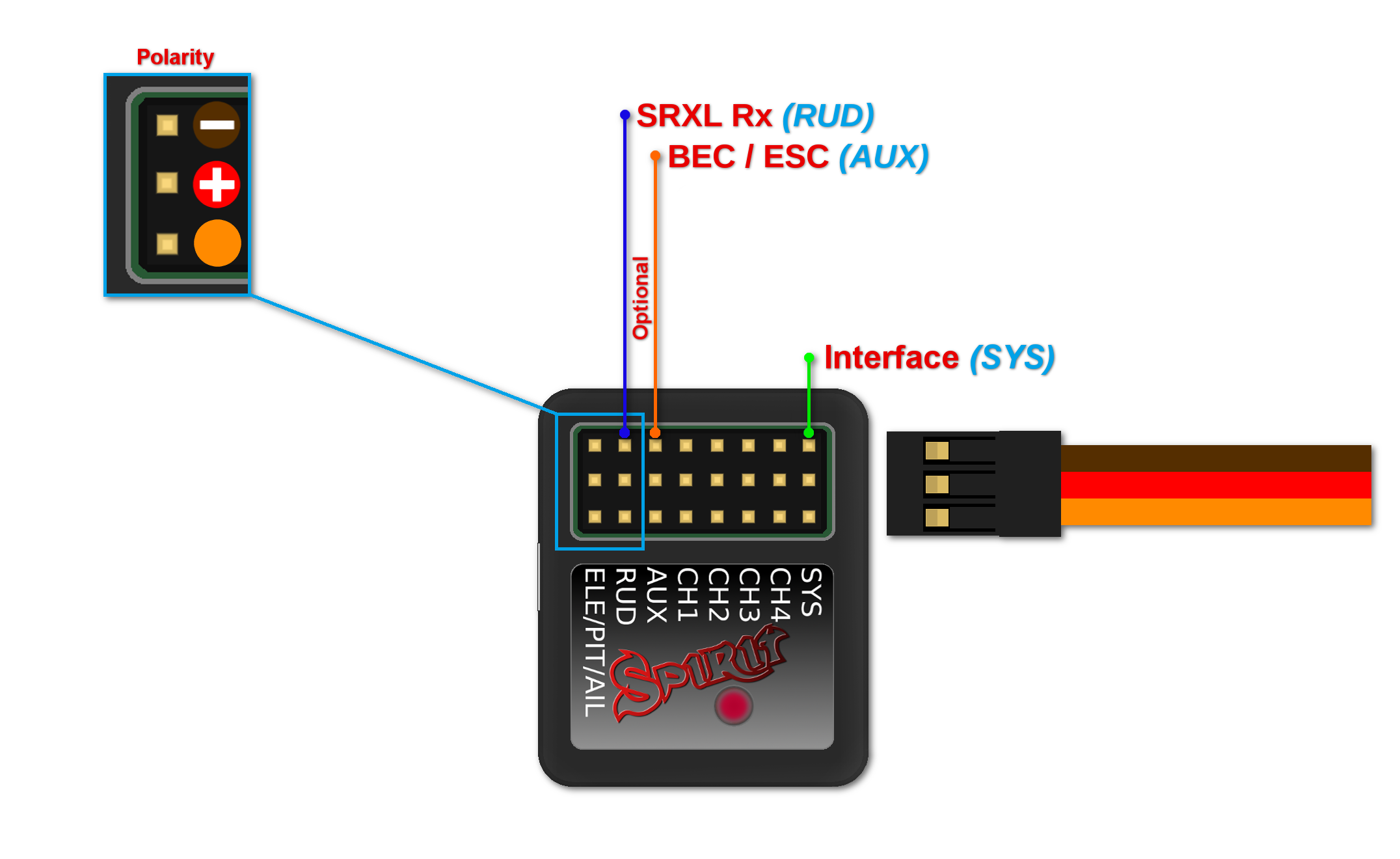Verkabelung
Die Verkabelung der Einheit hängt vom eingesetzten Empfänger ab. Das Spirit kann als unabhängiger Heckkreisel oder paddelloses System angeschlossen werden.
ACHTUNG
Das Spirit ist auf 1520μs Servo neutraler Impuls und 50 Hz Frequenz vorprogrammiert – bitte vergewissern Sie sich, dass Sie die richtigen Servo- Parameter, wie vom Servohersteller spezifiziert, ausgewählt haben.
Wenn der neutrale Impuls Ihres Servos anders wie oben genannt ist, wie z. B. 760μs, schließen Sie diesen Servo noch nicht an, da er zerstört werden könnte!
Einige Stecker haben keine Standardabmessungen, diese könnten nach dem Einstecken in die Einheit nebenstehende Stecker stören. Zur Lösung empfehlen wir, sie durch JR- oder Futaba-Stecker zu ersetzen.
Stecken Sie niemals einen Stecker zur Stromversorgung der Einheit in SYS oder ELE/PIT/AIL Schnittstellen oder Sie riskieren die Einheit zu beschädigen!
Contents
- 1 == UNABHÄNGIGER HECKKREISEL UND PADDELSTANGE ==
- 2 PADDELLOSES SYSTEM
- 3 CONNECTION OF STANDARD RECEIVER (PWM)
- 4 CONNECTION OF SPEKTRUM DSM2/X SATELLITE
- 5 CONNECTION OF FUTABA S-BUS RECEIVER
- 6 CONNECTION OF PPM RECEIVER
- 7 CONNECTION OF JETI EX BUS RECEIVER
- 8 CONNECTION OF SRXL/SUMD RECEIVER
- 9 CONNECTOR ORIENTATION
1 == UNABHÄNGIGER HECKKREISEL UND PADDELSTANGE ==
Eigentümer eines Hubschraubers mit Paddelstange können sich den „Heading Hold“ Kreisel zu Nutze machen, der das Heck in die vom Sendervorgegebene Richtung hält, unabhängig der Auswirkungen von Wind oder anderen Einwirkungen von außen.
Schließen Sie den Ruderservo an der CH4-Schnittstelle der Spirit-Einheit an. Falls Sie auch einen Standardempfänger benutzen, müssen Sie GEAR (oder AUX) von Ihrem Empfänger an der AUX-Schnittstelle an der Spirit-Einheit anschließen. Sie müssen auch Ihre Empfänger RUD-Schnittstelle an die RUD- Schnittstelle der Spirit-Einheit anschließen.
Auch wenn Sie einen Hubschrauber mit Paddelstange haben, können Sie die Einheit ebenfalls auf die gleiche Art und Weise anschließen, als ob Sie einen paddellosen anschließen würden. Dies erlaubt Ihnen, das volle Potential der Einheit einschließlich Stabilisierungs- und Rettungsmodus zu verwenden. Damit dies richtig funktioniert, muss der „Flybar mechanic“- Parameter in dem „Stabi“-Reiter während des Setups angeklickt werden. Alle anderen Parameter können genauso Konfiguriert werden wie bei einem paddellosen Rotorkopf.
2 PADDELLOSES SYSTEM
Paddellose Hubschrauber können alle Eigenschaften und Möglichkeiten der Spirit-Einheit nutzen. Das Spirit-FBL wird das Modell in allen Achsen stabilisieren und weniger windanfällig machen, die Flugzeit verlängern und die Wendigkeit des Modells erhöhen. Bei richtigem Setup sollten die Flugeigenschaften stabiler sein, was Ihnen das Vertrauen gibt, auch die herausforderndsten Manöver auszuführen. Anders als bei Hubschraubern mit Paddelstange sind die zyklischen Servos an einem paddellosem Hubschrauber direkter am Rotorkopf und den Rotorblättern angeschlossen, deswegen sind die Ansprüche an die Servos signifikant höher. Um diese zu bewältigen, sollten Ihre zyklischen Servos stärker sein, um damit umzugehen, und auch schneller, damit sie so schnell wie möglich auf jeglichen Befehl, den die Spirit-Einheit sendet, reagieren.
Paddellose Rotorblätter unterscheiden sich auch von Rotorblättern, die für Modelle mit Paddelstange entworfen wurden. Für beste Flugeigenschaften wird empfohlen, diese zu benutzen.
Wenn Sie die Spirit-Einheit als paddelloses System nutzen, sollten alle Servos an den entsprechenden Schnittstellen angeschlossen sein:
| Spirit |
| CH1 – Kollektiv (Pitch) / Querruder (Aileron) Servo |
| CH2 – Höhenruder (Elevator) Servo |
| CH3 – Querruder (Aileron) / Kollektiv (Pitch) Servo |
| CH4 – Heckservo |
| Spirit Pro |
| CH1 – Kollektiv (Pitch) / Querruder (Aileron) Servo |
| CH2 – Höhenruder (Elevator) Servo |
| CH3 – Querruder (Aileron) /Kollektiv (Pitch) Servo |
| CH4 – Heckservo |
| CH0 – auxiliary (optional) cyclic servo for CCPM 90 swashplate type. |
NOTE
Servos at positions CH1 and CH3 are dependent on the Swashplate settings.
Aileron servo on the model is mostly positioned on the right side while pitch on the left side.
3 CONNECTION OF STANDARD RECEIVER (PWM)
Spirit – receiver type: PWM
Spirit Pro – receiver type: PWM
For standard receivers it is necessary to use two normal and one special cable. Three connectors from the special cable should be plugged into the receiver and the end of this cable to the unit.
The unit is powered by two cables from the receiver connected to AUX and RUD positions. The Throttle cable should be connected to the receiver as well.
The easiest way you can start connect RUD with Rudder output in the receiver. Then continue with AUX which should be connected to the Gyro Gain channel output. Next, connect the Aileron, Elevator and Pitch (Aileron 2) channels. If you are not sure whether you have the correct output or not, you can plug in one servo and power the unit to verify that your connection is correct. This can be repeated for each servo. The diagnostics tab is very helpful too.
Never plug a connector for powering the unit to SYS or ELE/PIT/AIL ports.
4 CONNECTION OF SPEKTRUM DSM2/X SATELLITE
Spirit – receiver type: Spektrum DSM2/X
Spirit Pro – receiver type: Spektrum DSM2/X
Connection to a BEC is optional. If the model is powered by an external BEC, this must be connected to the RUD port. Also the power lead from the ESCs internal BEC must be disconnected.
To bind the satellites, insert a bind plug in the SYS port for DSM2 satellites or the ELE/PIT/AIL port for DSMX satellites. Power cycling the Spirit start the bind process. Once successfully bound, the STATUS LED will go out and the satellite LED will come on.
If the second satellite fails to bind, swap the satellites and repeat the bind process.
Be sure Receiver type in the software is configured to Spektrum DSM2/X or else binding process will not work. Never plug a connector for powering the unit to SYS or ELE/PIT/AIL positions.
5 CONNECTION OF FUTABA S-BUS RECEIVER
Spirit – receiver type: Futaba S-BUS
Spirit Pro – receiver type: Futaba S-BUS
Connection to a BEC is optional. For models of 500 size and larger it is recommended to use dual power supply cables due to the increased power consumption. That means besides the S-BUS cable, an additional power supply cable should be connected to the AUX port.
When using this type of receiver you can connect the throttle cable directly to the receiver. Alternatively, you can assign the throttle channel in the software and use the AUX as throttle output from the unit.
Never plug a connector for powering the unit to SYS or ELE/PIT/AIL ports.
6 CONNECTION OF PPM RECEIVER
Spirit – receiver type: PPM
Spirit Pro – receiver type: PPM
NOTE
Connection to a BEC is optional. For models of 500 size and larger it is recommended to use dual power supply cables due to the increased power consumption. That means besides the communication cable, an additional power supply cable should be connected to the AUX port.
When using this type of receiver you can connect the throttle cable directly to the receiver. Alternatively, you can assign the throttle channel in the software and use the AUX as throttle output from the unit.
Never plug a connector for powering the unit to SYS or ELE/PIT/AIL ports.
7 CONNECTION OF JETI EX BUS RECEIVER
Spirit – receiver type: Jeti EX Bus
Spirit Pro – receiver type: Jeti EX Bus
This connection type now supports the new integration with JETI Model transmitters. You can now fully configure the Spirit unit remotely through the JETI Model transmitter.
Remember to configure the receiver type through the software or the integration will not work. Also, it is necessary to download Spirit.bin file from the website. Move the file to the Devices directory in the SD card of your transmitter.
NOTE
Connection to a BEC is optional. For models of 500 size and larger it is recommended to use dual power supply cables due to the increased power consumption. That means besides the EX Bus cable, an additional power supply cable should be connected to the AUX port.
When using this type of receiver you can connect the throttle cable directly to the receiver. Alternatively, you can assign the throttle channel in the software and use the AUX as throttle output from the unit.
A special cable is needed to enable this communication.
Never plug a connector for powering the unit to SYS or ELE/PIT/AIL ports.
8 CONNECTION OF SRXL/SUMD RECEIVER
Spirit – receiver type: SRXL/SUMD
Spirit Pro – receiver type: SRXL/SUMD
NOTE
Connection to a BEC is optional. For models of 500 size and larger it is recommended to use dual power supply cables due to the increased power consumption. That means besides the communication cable, an additional power supply cable should be connected to the AUX port.
This protocol family can work with a wide range of receivers.
Thus you can use Multiplex SRXL, BeastX SRXL, Graupner SUMD, Jeti UDI, Spektrum SRXL and more.
When using this type of receiver you can connect the throttle cable directly to the receiver. Alternatively, you can assign the throttle channel in the software and use the AUX as throttle output from the unit.
Never plug a connector for powering the unit to SYS or ELE/PIT/AIL ports.
9 CONNECTOR ORIENTATION
All cables connected to the unit must be oriented so that the signal wire (Lightest color wire) is closer to the connector pin label, towards the center of the unit. This orients the negative (darkest color wire) toward the edge of the unit.











